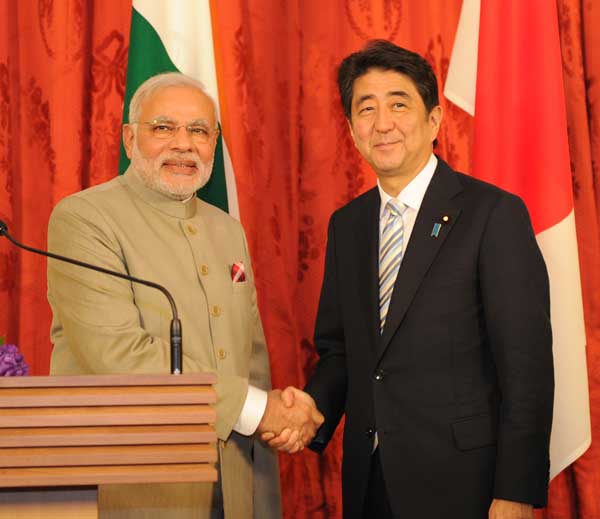Indo-Japanese ties have seen what one can call an irresistible change in the last two decades. The growth to present day strategic partnership has been on the basis of common democratic values and market principles. These commonalities have seemed enough for both countries to realise how a strong partnership among them could dramatically affect the balance of power in the region.
The most recent visit of Japanese Prime Minister Shinzo Abe to India has been a positive step towards attaining what has been termed as a “Special Strategic and Global Partnership” (working towards which has taken almost over a decade) with the agreement on major deals such us the introduction of Japanese technology of Bullet train, stronger defence cooperation and a nuclear partnership deal among many others.
It would seem almost inevitable for the two countries to come together in what can be quoted from Japanese PM’s speech as “The Confluence of the Two Seas” adding to which he believes “Japan-India relationship is blessed with the largest potential for development of any bilateral relationship anywhere in the world”. Words of such force can form the basis for an infallible bilateral relationship changing the entire course of power play in the region as well as world over.
The Indo-Japanese relationship has been a paradox. There is no major dispute between the two in the past but the richness in the relations has not been exploited for many years. The dynamic nature of international relations has led to many implausible partnerships among nations in the past but what comes as a surprise is the long time it has taken for this stage in Indo-Japanese ties. There may not have been gasps in the international political arena over this assemblage but the scepticism shouldn’t go unnoticed. To offer food for thought; some believe that it is a way of Japanese and American administration to make India ‘swing’ towards their alliance; this being the result of a strategy to contain the rise of China in the region. If it be true in its entirety, it could lead to a catastrophic situation if not handled well by India, also in view of Indian relations with Russia. Regional control cannot come at the cost of National Interest which would always be in favour of continued friendly ties with Russia as well.
The “Diamond Concept” by PM Shinzo Abe, introduced in 2012 which had proposed a virtual security diamond among Japan, India, USA and Australia (in line with the Indo-Pacific maritime cooperation), is still being taken up as one of the key national strategies for Japan. What still might come as a surprise is the swiftness for the need to sign the peaceful use of nuclear energy deal and civil nuclear cooperation. This being in sudden contrast to Japanese pacifist foreign policy in the past and the nuclear non-proliferation stand which did not support India’s nuclear testing earlier on. It is true that Japan realizes the true naval potential of India which can be backed by AT Mahan’s Political Geography theory, given the factors that it fulfils of geographical position, physical conformation, extent of territory, size of population, character of people and that of the government. This being said Japan would need India to stabilise the Indian Ocean region. “A strong India is in the best interest of Japan, and a strong Japan is in the best interest of India” is a statement by Japanese PM Shinzo Abe that clearly supports it.
As per the Japan-India Vision 2025 Special Strategic and Global Partnership document (which was the resulting document of PM Abe’s visit), there was a realised need for a more robust cooperation in security issues with the acknowledgment of the need for stability of the Indo-Pacific region as being of utmost importance for the national security of both the countries. Japan-India and USA working in Unison for the Malabar exercises was an offer duly honoured by Japan in 2014 which was the initial glimpse of the long-standing need for maritime cooperation between the two nations of the region. Helping India in its Defence development, there was an agreement too signed for the transfer of Defence Equipment and Technological Cooperation between both the countries. This would make available defence equipment and technology for carrying out research, development and even production projects. This also would help Japan realise the opportunities available for its defence industry growth in India and in return offer India a ray of hope in accelerated defence modernisation. Though this agreement is as beneficial for one nation as it is to other, the extent of Japan’s willingness to impart with technological knowledge cannot be a promise that may be as promising in the end. This improbability also comes from the fact that Japan has concentrated mostly on its domestic defence market in the past. Japan’s commitment to peace can to some extent then seem as a veil that might cover quite a few hidden ulterior motives.
India’s ‘Act East Policy’ does coincide well with Japanese interest of investing in India extensively on infrastructure building and also following the support of government projects like “Make in India” and “Swachh Bhaarat”. The project in the spotlight, the showcase of this partnership, i.e. the Bullet train from Mumbai to Ahemadabad, can have a few of us up in knots. Simply for the fact that Japan offers to finance 80% of the cost of the project on an interest rate that is less than a percent. Japan being an island nation has been strongly working towards climate control and environmental preservation and the environment in a nation like India in its region does become its concern. China is India’s biggest trade partner and in recent times the ratio of imports from China to its exports became 4:1. This was an alarming statistics and so India has ever since tried to alter its domestic manufacturing markets and trading trends. Japan, in the light of such a situation, offers a lot of scope for change. If there is the forceful progress in the China Pakistan Economic Corridor (CPEC), India and Japan too have a promising relationship for the future and progress of the Asian continent.
A close understanding of Abenomics leads to believe that the Abe government in its present economic policies is majorly concentrating on making its domestic environment more dynamic, with the help of a monetary policy that stimulates the economy. There is also a need for structural reforms in the Japanese economy (mostly the corporate) sector. This has gained clarity after the Bank of Japan announced a negative interest rate on 29th of January 2016. Something that shocked the entire world and a move never made in this part of the region. The turbulence in the Japanese economy becomes clearly evident. With closer ties now and hopingly even closer ones in the future, this can have an effect on Indian economy too. India too can help to a great extent if Japan makes its policies friendly towards immigration of unskilled labourers from India. Japan has a great need for a structural reform in the labour market and India has human resource to offer.
“Japan has been making contributions to the development of India through quality infrastructure that has outstanding economic efficiency, is in harmony with the environment, and is long lasting. One excellent example of this is the Delhi Metro, which is serving as an essential public transportation system for the people of Delhi. I am extremely happy that Prime Minister Modi also shared his hopes, saying, “No nation has contributed so much to India’s modernisation and progress like Japan”. These words by PM Abe are comforting to national image.
The bonhomie of India-Japan is a cornerstone in the Asian influence in the world but this doesn’t brush off the possibilities of India being a stepping stone for Japanese interests of counterweighing Chinese influence in the region. It is also clear that this isn’t the only reason the two nations have come together. The UNSC (reforms) stand by both the nations still does make them contenders for a permanent seat, even though both the nations may be working towards the UNSC reforms together. In other words, India can celebrate this partnership while gulping on the fact that an unknown trouble is never as easy to deal with as is a known one, but the Asian age is a vision that is only possible with the continued geniality of one of the two major powers of the region.
References
- http://www.thehindu.com/news/national/japan-keen-on-making-in-india/article7978143.ece
- http://www.thehindu.com/opinion/editorial/shinzo-abe-in-india-cautious-cooperation-with-japan/article7987950.ece
- http://www.thehindu.com/news/national/india-needs-highspeed-growth-modi/article7980222.ece
- http://www.idsa.in/idsacomments/make-in-india-scope-for-india-japan-defence-cooperation_tbasu_291215
- http://www.dsalert.org/int-experts-opinion/international-geo-politics/516-why-japan-needs-india-as-strategic-partner
- http://thediplomat.com/2015/12/abes-visit-takes-japan-india-security-relations-to-the-next-level/
- http://economictimes.indiatimes.com/news/politics-and-nation/India-and-Japans-relationship-has-greatest-potential-in-the-world-Shinzo-Abe/articleshow/50134219.cms
Courtesy: http://www.claws.in/1535/india-and-japan-boarding-the-shinkansen-hargunh-kahlon.html





